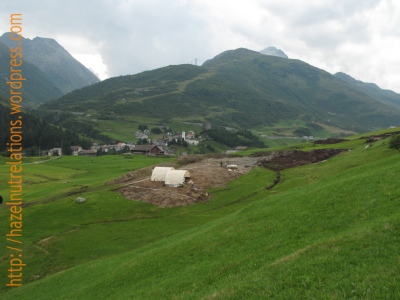Last Friday a team of archaeologists – amongst which I was lucky to count myself – finished the excavation of a Late Mesolithic site (at ~1475masl) on a future golf course near Andermatt, Canton Uri, Switzerland.
It wasn’t really planned like that, but this summer has seen me digging in the Alps quite a bit, and I will write a little something about that archaeology here, starting with the Andermatt dig:
Archaeologically supervising the construction of a golf resort
The excavation, carried out by ProSpect gmbh and commissioned by the Canton Uri, was the result of a small – much too small for such a huge area, actually – survey project and building brief at the construction site of a golf resort on the valley floor of the Urseren Valley between Andermatt and Hospental. The Canton of Uri, sadly, has not got an archaeological unit, so that there is hardly any archaeological research, ot even rescue excavation done here and the authorities are not familiar with what it means to investigate archaeological sites. So, we got the work rather late and while the building had already started. Because of the nature of the work[i] and the small budget for such a large area, it was also not possible to investigate the whole of the construction site. It was one of the very first rescue archaeology projects carried out in the Canton Uri (Hess et al., 2010). But the canton is trying build up something and has just announced their cooperation with the Kantonsarchäologie Kanton Zug[ii] This announcement and the site got quite a bit of coverage in the local and national media [see links below].
Rescue excavation of a Late Mesolithic site
A number of areas showed some archaeological promiss, but it was not until Chr. Auf der Maur found a few crystal artefacts, that we could convince the authorities to allow a bigger excavation. One of these crystal artefacts was a small Late Mesolithic trapeze, hence it is the earliest known direct evidence for human occupation of the Canton Uri! We were granted 3 weeks time to excavate as much of the 7x9m large site as possible. Not ideal circumstances. Also, 20cm of topsoil were already stripped off by the mechanical digger and it had cut two hearths a bit further away[iii]. We were able to put a cross over the main part of the site, dig and document some more of this and the hearths. The dirt was wet-sieved or packed up to be sieved later.
Some preliminary results and a look into the future
The site turned out to be quite rich in artefacts, most were made of rockcrystal, a few of another raw-material (probably “Ölquartzite“). Not all the earth has been sieved and the finds have not been analysed yet, but it can already be said that we have a nice little assemblage from the site. Now we’re waiting to see if it will be possible to do some post-ex and analysis of at least some of the archaeobotanical samples, analyse and publish the finds and send away some C14 samples. Further samples taken include wood for dendro-analytical analysis from various moors (by M. Schmidhalter) and an archaeobotanical drill-core from a moor (by J.-N. Haas) just next to the excavated site.
The results of the fieldwork we just finished and that done by the Universität Zürich (Hess et al., 2010) might create an awareness that the Urserental has a much deeper and richer history as many people might expect. However, this awareness could come just too late. As mentioned before, the cultural heritage management situation in the Canton Uri is far from satisfactory. The discovery of the Mesolitihic site and the corporation with the archaeological unit of Canton Zug and the media attention it received might improve the situation. Even if it came too late for parts of the Urserental, it would still be valuable for the rest of the Canton. It might make people realise that their surroundings, the places they live in have more than an economical value. And that, if we have to intervene in these places, the least we should do is to investigate them and preserve the archaeological record. For now we are happy to at least have been able to investigate part of this significant archaeological site and are looking forwards discovering more during the post-ex work.
A few more Photos and some information in German here!
TV-Documentary of the Swiss Television
But I’ve been in the lowlands too long, so I’m off digging in the Alps again.
Here some infos in German and a few photos of the excavation.
Bibliography
HESS, T., REITMAIER, T., JOCHUM ZIMMERMANN, E., BALMER, A., DOBLER, I. & DELLA CASA, P. 2010. Leventina – prähistorische Siedlungslandschaft. Arcäologischer Survey im alpinen Tessintal und entlang der Gotthardpassroute 2007/2008: kommentierter Katalog. Jahresbuch der Archäologie Schweiz, 93, 173-193.
[i]Those of you having done buildingbriefs on golf courses will know how erratic those people work, how much earth they move and how difficult it is to supervise the work archaeologically.
[ii] Archaeological Unit of the Canton Zug
[iii] Dates are still unknown.





Pingback: Archäologie des Gotthards Teil III | Alpine Archäologie
Pingback: Digging a multi period site in the southern Swiss Alps |
Pingback: The Middle Ages and the Middle Stone Age – rock crystal tools and stone walls | hazelnut relations
Pingback: A Day in Swiss Rescue Archaeology | Day of Archaeology